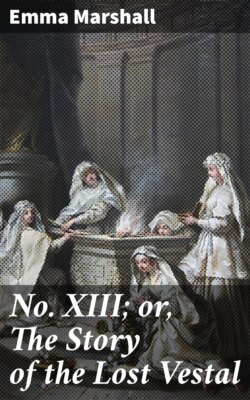Читать книгу No. XIII; or, The Story of the Lost Vestal - Marshall Emma - Страница 3
На сайте Литреса книга снята с продажи.
INTRODUCTION.
ОглавлениеTable of Contents
Recent discoveries in the Roman Forum have brought to light many interesting relics. Amongst these are the statues of the Vestales Maximæ, of which, in spite of the efforts of the lime-burners and stone-cutters of the Middle Ages, who were distinguished for their work of wholesale destruction, thirty-six inscriptions, and fourteen statues, have been discovered.
The pedestals on which the statues were placed bear inscriptions, and the names of the Vestales Maximæ whose virtues are recorded.
There is one exception—the name is carefully erased—and we can know her of whom so much is said in praise, only as Number Thirteen.
An attempt has been made to clothe the memory of this Vestal with some probable, though of course wholly fictitious, incidents; and to assume as a certainty the idea, which has been thrown out as a possibility, that her conversion to Christianity was discovered, and that one in authority desired to leave no trace of her family or her name to future generations.
But, though her name has perished, her virtues remain engraven on the imperishable stone, and these help us to call her before us, in all the grace and dignity of a beautiful life, passed in the cloisters of the Vestals’ home.
The incidents which have gathered round her supposed history, are more or less connected with the persecution and martyrdom of the Early Church in Britain, and afterwards in Rome.
A glance like this into the past may be made useful to the young reader, if it should quicken a desire for the intelligent study of history, and help the student to look upon the events of bygone ages as they affected real men and women, who had the same hopes and fears, and aims and ends, as we have, who are living so long after them.
We are, naturally perhaps, too apt to think of those of whom we read in these distant ages, as myths rather than as the brothers and sisters of the one great family of God, to which we all belong. Their human hearts beat with the same affections as ours, and through the mists of superstition and ignorance the lamp of an undying love shines out here and there, as a light in a dark place.
Thus, through the symbol of the sacred fire, which the Vestals vowed to keep for ever burning, we may see the foreshadowing of the mission of every Christian woman, matron or maiden, whose high vocation it is to keep the light of truth, purity, and love, for ever burning in her daily life, and by giving light to those around fulfil the command of her Master, when He said—
“Let your light so shine before men, that they may see your good works, and glorify your Father which is in heaven.”
